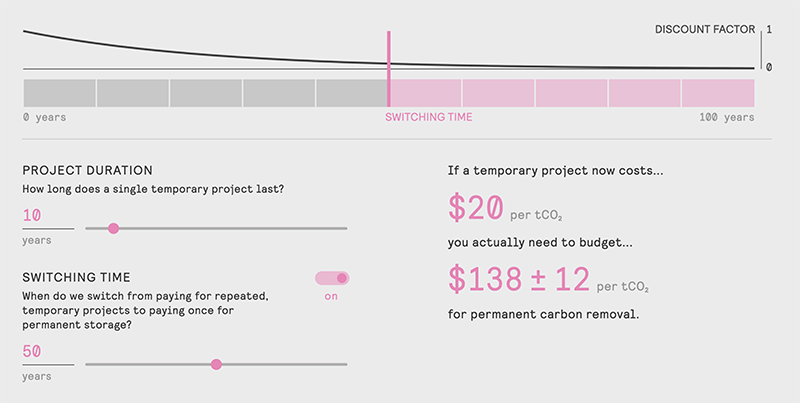
This blog explores three key issues that are crucial to the success of scaling carbon removal strategies effectively and equitably.
The 2000s are often referred to as the “lost decade” of climate action. After many years without meaningful steps to dramatically reduce greenhouse gas pollution, the Paris Agreement’s goal of limiting warming to 1.5°C is slipping out of reach. In parallel, a growing number of companies and governments have announced ambitious pledges to achieve net-zero emissions that rely, in part, on carbon dioxide removal (CDR).
Interest CDR has never been higher, but successfully scaling an effective and socially equitable portfolio of CDR options requires a careful understanding of past problems and ongoing challenges. This post provides an overview of three key issues:
- variation in the permanence of carbon storage,
- accuracy in measuring real climate benefits, and
- concerns around the conflation of carbon dioxide removal with traditional carbon offsets.
Permanence
CDR produces climate benefits by literally removing carbon dioxide from the atmosphere and sequestering it somewhere else. Reducing atmospheric carbon dioxide concentrations lowers the pace of global warming, but only so long as the carbon dioxide stays out of the atmosphere. Getting the timeframe of carbon storage right is a critical issue because temporary removals produce only temporary benefits — yet that’s what many of the lowest-cost CDR options produce today.
Some carbon removal methods are at a higher risk of reversal than others. For example, the now-annual wildfires in the Pacific Northwest have burned away forests that are part of California’s forest carbon offset program. Although these forests were supposed to provide climate benefits for 100 years, a large fire in Oregon burned a significant area of an offset project, sending a significant share of forest carbon back into the atmosphere. California’s program includes an insurance mechanism to cover unexpected losses from such projects, but unfortunately that system doesn’t take into account geographical variation in risks nor the fact that wildfire risks are rising along with the planet’s temperatures — and as far as we know, no public or private protocols are yet doing any better. (It’s worth noting that most forest carbon offsets, including California’s, do not primarily produce carbon removal. Instead, most “improved forest management” credits are avoiding emissions as landowners promise not to harvest forests in exchange for valuable carbon credits.)
Other carbon removal strategies result in longer-term storage. For example, direct air capture uses chemical reactions to pull carbon dioxide out of the air. Carbon dioxide can then be mineralized, transforming it into what is essentially a rock. It can also be injected into saline aquifers and other geologic formations. The risk of seepage where the CO2 escapes back into the air is higher in these formations compared to mineralization, and varies across geographies depending on the regulatory requirements. Industries have been injecting carbon dioxide underground for decades, with an estimated 78% to 98% of injected CO2 remaining underground for the next 10,000 years. In the United States, state and federal regulations — such as California’s Low Carbon Fuel Standard and the U.S. Environmental Protection Agency’s regulation of Class VI injection wells — provide a blueprint for monitoring and strengthening of public oversight over underground carbon storage.
Differences in the permanence or duration of carbon removal make it hard to evaluate the cost of competing CDR strategies. To help those designing or procuring carbon removal strategies, Climateworks and CarbonPlan partnered to produce a permanence calculator.

Because competing carbon removal projects feature different time horizons over which carbon is removed and stored outside the atmosphere, it is difficult to compare their relative costs. The calculator shows how different combinations of temporary and permanent carbon storage projects produce permanent climate benefits, helping users such as governments and corporate decisionmakers explore the levelized cost of alternative CDR strategies. A key insight from this analysis is that the full economic cost of a permanent carbon removal strategy based on temporary carbon removal efforts can be significantly higher than the upfront cost of a single, short-duration project — in other words, a big part of the current cost difference between temporary and permanent carbon removal projects reflects the greater climate benefits delivered by permanent efforts.
Accurately measuring CO2 removal
It might sound deceptively simple, but accurately measuring carbon dioxide removal is another important and often overlooked challenge. For some approaches, particularly those involving biological systems, complex science and new technologies are needed to get a clear and cost-effective handle on the carbon cycle implications of changes in land management.
The good news is that technology is progressing in many of the most challenging areas of measurement. The field of forest ecology, for example, has benefited from recent innovations in remote sensing from satellites and Lidar, enabling reliable carbon accounting at the landscape level. However, the ability to use low-cost remote sensing to generate broad insights is based, in no small part, on the fact that the U.S. government has been collecting public forest data for almost a hundred years; related projects in other areas of the world will continue to help ground-truth remote sensing techniques around the planet.
For carbon removal approaches that vary widely by location and land management practice, such as soil carbon, reliable quantification methods remain to be developed. New investments in public data collection could help calibrate and leverage remote sensing in some of these areas. While potentially expensive to scale, ongoing ground-truthing is required to provide confidence in climate outcomes.
For direct air capture and carbon mineralization, reliable measurements of volumetric carbon dioxide flow are more straightforward. For example, as part of the CarbFix project in Iceland, CO2 removed by direct air capture machines is then dissolved in water and passed through underground basalt aquifers to form carbonate minerals. The volume of CO2 removed in the direct air capture stage is easy to measure because it is 99% pure once it’s separated by heat from the chemical filters. After injecting this reliably measured flow underground, calcium isotopes are used to accurately quantify the amount of carbonate precipitated, and derive the amount of CO2 stored. Current tests suggest an overall carbon removal efficiency of 72 ± 5% via this method.
The need to differentiate carbon dioxide removal from traditional carbon offsets
The carbon offset concept was created decades ago as a way to lower the costs of mandatory carbon pricing schemes. At the time, it was thought that a global tax or carbon trading system was the most promising strategy to reduce greenhouse gas emissions. Offsets would help keep mitigation costs in check by allowing low-cost emission reductions from somewhere else to relieve expensive reductions required at home. For example, consider a refinery that, rather than spend billions on retrofits, pays a timber company not to cut down its forests for a prescribed period of time. The refinery keeps pumping carbon into the air, and the timber company makes a claimed change in its harvest rotations somewhere else.
As with many well-intentioned policies, the devil is in the details. Offsets have faced a variety of challenges, including consumer distrust in measurement, reporting, and verification; carbon leakage; and depending on the regulatory framework, perverse incentives to increase pollution in order to claim more credits. Meanwhile, concerns about the environmental justice implications of shifting where emissions are reduced — along with the co-benefits they generate locally — have led to growing community resistance to carbon offsetting policies. Our experience in climate action has taught us that developing broad social trust and buy-in are essential to successful mitigation strategies; more than one viable approach — such as carbon capture and storage as well as nuclear power — has been shelved due to a lack of public trust. As experience with the problems of carbon offsetting grows, equating traditional offsets with carbon removal risks creating guilt by association.
Carbon removal is at a critical juncture, both in the sense that many promising approaches are being tested in the field and that many public and private actors see the need to scale removal to address those emissions we can’t avoid in the decades ahead. The risk that carbon removal will be equated with traditional offsets is particularly concerning because the private market for carbon removal credits is almost entirely co-mingled with the incumbent carbon offsetting industry. This is a problem because traditional offsets credit activities avoid or reduce CO2 emissions, which competes with climate mitigation, whereas carbon removal addresses a different problem — cleaning up pollution from sources that remain or can’t be reduced after serious mitigation occurs. The economics of this co-mingling also work at cross purposes, because currently high-cost, high-quality carbon removal options can’t compete with cheaper traditional carbon offsets in the same market.
Carbon removal needs to take lessons from the challenging experience with carbon offsets to develop a robust regulatory framework that is realistic about the political self-interest of its participants. Supporters need to commit to serious and sustained vigilance to fight back against rent-seeking behaviors from companies and industries that want to take advantage of the positive perception of and support for carbon removal, whether those efforts are focused on “nature-based” solutions or cutting-edge industrial technologies that appeal to different customers and political constituencies.
Establishing a better framework is critical because the time horizon to achieve net-zero emissions is rapidly shrinking. Large-scale carbon removal could be needed as a climate backstop to neutralize remaining emissions from hard-to-decarbonize sectors such as agriculture and long-haul aviation. If the pace and extent of technological progress in these difficult sectors doesn’t accelerate, then a greater reliance on carbon removal might also be needed as a bridge to deeper climate change mitigation, or as a means to withdraw excess historical emissions from the atmosphere. Defining the conditions under which carbon removal is acceptable at scale is a complex and ethically challenging task that must be done transparently in order to avoid the “lock-in” of incumbent industries as well as the significant environmental and social consequences of large-scale CDR.
Conclusion
The world’s inability to agree upon and enact a coordinated and ambitious climate change mitigation strategy has now put us in a place where large-scale carbon removal will likely be needed as a complement to deep and sustained cuts in climate emissions — not as a replacement. The world must now invest heavily to scale up carbon removal solutions. A comprehensive investment strategy must be guided by a clear sense of the challenges that have come before as well as the complexity that lies ahead. We hope this short post provides a helpful description of three areas where additional work is needed from all stakeholders to set global CO2 emissions on a path to net zero by mid-century.




